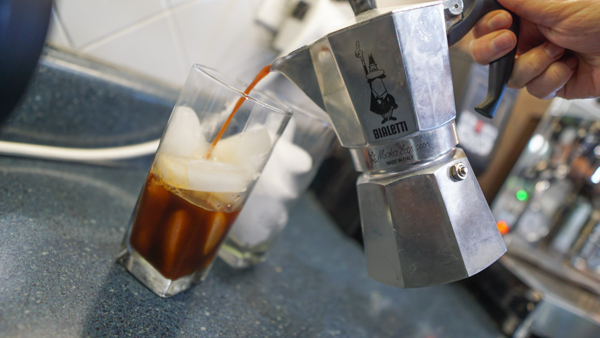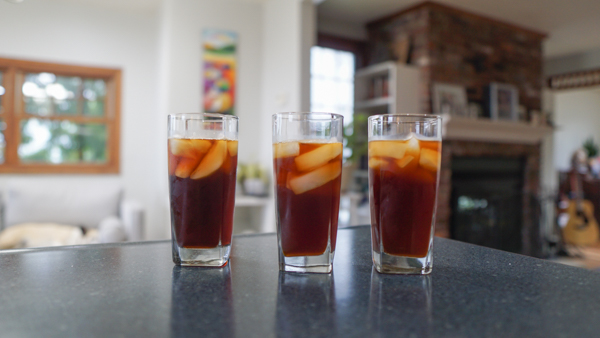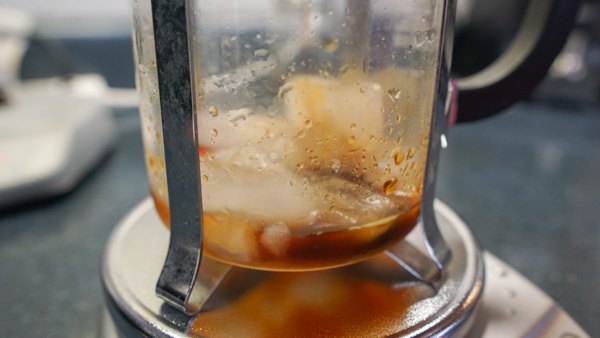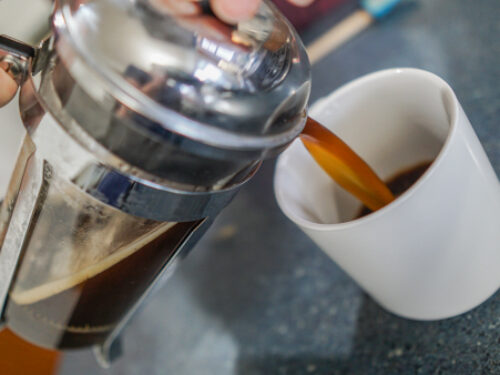Disclaimers: Our site uses demographic data, email opt-ins, display advertising, and affiliate links. Please check out our Terms and Conditions for more information.
As much as I love sitting down to a big mug of hot coffee, when the summer heat is oppressive I find myself gravitating toward cold coffee drinks instead. There are several different techniques for making cold brew coffee, but most all can be classified as either immersion techniques using room temperature water, or regular brewing techniques using hot water that is subsequently flash cooled over ice (which is not inherently cold brew, but is often discussed in the same breath).
We've always wondered if there was any difference in the resulting flavors from these different types of cold brew techniques, so we decided to put them to the test. We tried several different cold brew techniques and found a clear winner; in this post we'll share our recipes and results from each test along with a little theory behind cold brew.
Room Temperature Immersion Method
This is the simplest of all cold brew techniques. It doesn't require any fancy equipment – if you have a coffee grinder, a vessel of some sort, and a straining implement you can make this technique work.
Basically the idea is to grind coffee coarsely, add cold water, and let it set for an extended period of time before straining and diluting to taste. The advantages of this technique are that it doesn't require any special equipment and that it enables you to brew a pretty large volume ahead of time and store it in the fridge for a week or so.
Equipment You'll Need for Immersion Brewing
- Burr Grinder
- A kitchen scale
- A glass jar or other vessel for brewing
- Coffee cups
Recipe
- Roast: Medium
- Coffee: 30 g per serving
- Water: 180 g per serving
- Temperature: Room Temperature
- Grind: Coarse (4 of 16 on Grinder)
The process for immersion brewing is pretty simple. Grind coffee coarsely and combine with water in a covered vessel. Let sit at room temperature for 8 hours.
Once the time has elapsed, filter using a fine mesh strainer, cheesecloth, or coffee filter (we used a Hario V60 filter placed in the V60 dripper). Store in your fridge until you're ready to consume and then dilute at a 1:2 volume ratio of concentrate to water/milk and serve over ice.
Flash Iced Methods
Flash iced methods can be done with most any regular brewing technique and involve brewing at a higher coffee to water ratio than you would for a hot brew, and brewing directly onto ice to rapidly cool the coffee.
For our experiments, we've tried using Aeropress, Hario V60, and a Bialetti Moka Pot for flash iced brewing, and our clear favorite has been Hario V60- of which our recipe is below.
Equipment You'll Need for Flash Iced Brewing
- Burr Grinder
- A kitchen scale
- Your favorite brewing method (Aeropress, Hario V60, Moka Pot)- we use Hario V60 below.
- A glass jar or other vessel for brewing
- Coffee cups
Hario V60 Recipe
- Roast: Medium
- Coffee: 22 g per serving
- Water: 200 g per serving
- Ice: 75 g per serving
- Temperature: 205°F
- Grind: Medium (8 of 16 on Grinder)
Place the ice in the carafe or vessel you'll be brewing into, and brew as you normally would for a Hario V60 but with the modified weights above (our full Hario V60 recipe is available at the previous link).
In our conventional pourover brewing, the water-to-coffee ratio is 15 : 1. When doing iced coffee, we brew a bit more concentrated at 9 : 1 and then have extra water in the form of ice which will dilute to a final ratio of 12.5 : 1. As this ice melts when brewing, we add more ice into the serving cups which will melt over time and near the finish will likely get a bit closer to the 15 : 1 ratio we use in hot brewing.
If using other brewing methods, we like using more coffee (~10%) and less water (25-33%) such that you end up brewing a concentrate. The water you saved in this step can then be used for the balance when flash icing and serving. The only exception for this is the Moka Pot in which we brewed normally and simply poured over ice as the brewing volume is quite low to begin with.
Room Temperature Brewing vs. Flash Iced
We brewed a single origin Ethiopian bean with both of the above techniques and did a double-blind taste test of the resulting brews. We were really surprised that there was a clear winner here: the flash iced V60.
While the coffee brewed at room temperature was totally smooth, rich, and not bitter at all, it lacked some of the more delicate aromas of the flash iced V60.
The flash iced V60 was an explosive fruit bomb with more acidity and brightness than the coffee brewed at room temperature. Given that we love fruity and acidic coffees, and that we were brewing using a fruity, lightly roasted Ethiopian, it's no surprise that this was our preference.
That said, if you prefer darker, richer flavors or less acidity in your coffee, you may prefer using a darker roasted coffee and brewing at room temperature. We also think the room temperature method is better suited to the addition of milk than the flash iced method – if you add milk to a flash iced brew you cover up all of those delicate and fruity aromas that make the brew unique.
Overall, our results make sense when considering how the brewing temperature affects coffee extraction; more acids and bitter compounds are extracted at the higher brewing temperatures of a flash iced brew, whereas these compounds aren't extracted as much with room temperature water, resulting in a smoother and less acidic brew.
While this one may come down to personal preference more than anything, one thing is for certain- it is a fun test to do to find which one you prefer yourself!
Do you have a great cold brew recipe we should try? Comment below to share!








